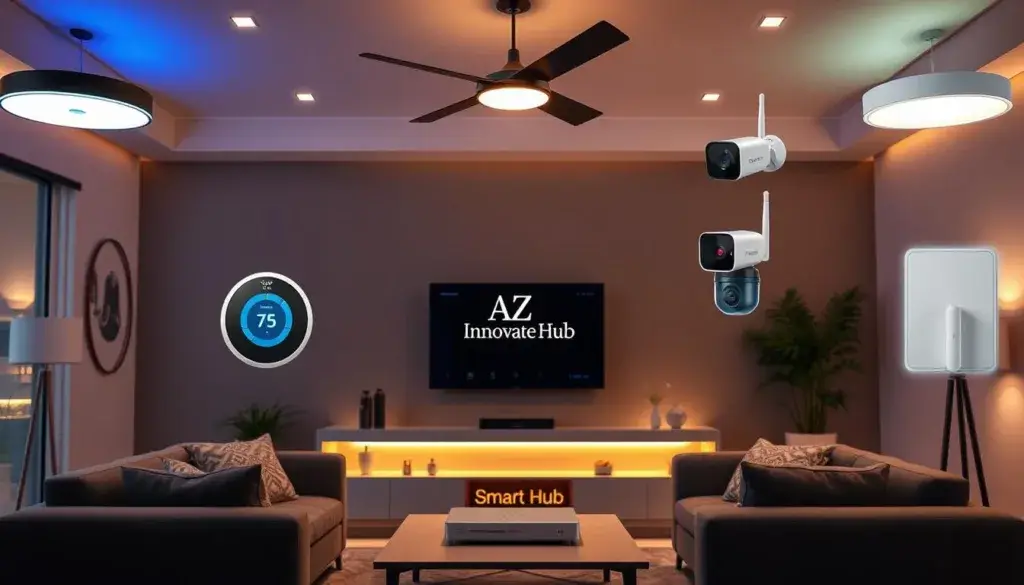
Imagine walking into a home where the lights adjust to your favorite movie. The thermostat changes to the perfect temperature when you arrive. And advanced security options watch over your home, all controlled by your voice or a tap on your phone. Welcome to the smart home era, where life is made easier, safer, and more energy efficient.
IoT devices are changing how live at home. Your can have lights that show 16 million colors or thermostats that learn your schedule. Whether you are tech-savvy or new to home automation, this guide will help you turn your home into smart haven.
Key Takeaways
- Smart home devices offer enhanced convenience and efficiency.
- IoT solutions help automate everyday tasks for a smoother lifestyle.
- Advanced security systems provide peace of mind and safety.
- Energy-efficient technologies help reduce utility bills.
- Voice control integration simplifies device management.
The Advantages of a Smart Home Setup
Smart home technology is becoming more popular. It offers many benefits that make our lives better. These include better security and saving energy, making our homes safer and more convenient.
People are using smart lighting, thermostats, and entertainment systems. These tools make our homes more efficient and enjoyable.

Smart Lighting Solutions
It changes how we see and use our homes. With products like Philips Hue bulbs, we can adjust the light’s brightness and color easily. This can be done through apps or voice commands.
This not only improves our mood but also saves energy. We can set schedules and track how much energy we use. This helps lower our electricity bills.
Smart Thermostats and Climate Control
Smart thermostat like the Nest Thermostat, change how we control the temperature. They adjust the temperature based on what we like and how we use it. This saves energy and keeps us comfortable.
We can change the temperature from anywhere. This means our homes are always at the perfect temperature when we get home.
Entertainment Systems
Smart entertainment systems make watching listening to music easy. With devices like smart speakers and streaming sticks, we enjoy our favorite shows and music anywhere in the house.
This makes our free time more fun and efficient. We can easily find and play our favorite content without hassle.

Smart Home Hubs: Centralizing Control
Smart home hubs are key to connected home. They act as the main control point for many IoT devices. Users can manage devices like smart sensors, lights, cameras, and appliances from one place.
These hubs support different communication protocols like Zigbee, Z-Wave, and Bluetooth. This makes devices interactions more efficient and reliable. Models like the Samsung SmartThings Hub, Wink Hub, and Philips Hue Bridge show their great capabilities.
Choosing the right smart home hub is important. Look at voice control, integration, and operating systems compatibility. Also, consider connection requirements and device standards for a good home automation experience.
New protocols like Matter aim to improve device interaction. But hubs with Thread are needed for full integration. Some hubs work well across different ecosystems, offering better control.
Security is crucial for smart home hubs. There have been reports of vulnerabilities. Keeping software up to date and using multifactor authentication (2FV, 2FA) can help keep your home safe and efficient.

Best Voice Assistants for Home Automation
Voice assistants in homes have changed how we use smart devices. Amazon Alexa and Google Assistant are two top choices. They work with many smart home products, making voice control easy.
Amazon Alexa is known for its big list of compatible devices. You can use voice commands for things like turning lights on and off. The latest Amazon Echo Pop is around $60, which is a good deal for many families.
Google Assistant is also easy to use. New devices like the Google Nest Mini 2nd Gen let you control smart home gadgets with your voice. Most smart speakers use either Google Assistant or Amazon Alexa, showing how popular they are.
Smart displays have speakers and touchscreens for video calls and controlling gadgets. They connect via Wi-Fi, and HDMI eARC, making them versatile.
When picking a voice assistant, think about what you need for your home. Amazon Alexa and Google Assistant are key parts of smart homes today.

Setting Up a Smart Home: Simple Guide
Starting a smart home can seem daunting, especially for newbies. Begin by picking devices that fit your needs. Start with smart speakers and bulbs to control lights and set moods.
Then, add smart thermostats to save energy. They adjust your home’s temperature from afar. Don’t forget about security: smart locks and cameras offer peace of mind.
Using a central hub makes things easier. Google Home and Amazon Echo are great choices. They let you control many devices at once.
Google Home works with lights, cameras, and TVs. Amazon Echo is great for home theaters and plugs. For more control, Samsung SmartThings or Wink are good options.
Managing apps can be a hassle. But with a hub, you can link everything together. Google, Amazon, and Apple offer unique benefits. Google is good for talking commands, Amazon for wide compatibility, and Apple for security.
When buying devices, check for compatibility logos. This ensures they work well with your hub. Follow this guide to create a smart home that fits your life perfectly.
Ensuring Security and Privacy in a Smart Home
More people are using smart home technology but worries about privacy and security are growing. A study found that 55% of people are very concerned about their data safety in smart homes. They rate their worries between 6-7 out of 7. It’s clear that we need to make our smart home safer.
Keeping devices up to date is a key way to protect against hackers. Using strong passwords’ and two-factor authentication or two-step verification adds extra security. It’s also important to check how companies use your data. Smart devices collect personal info, so it is crucial to know how they use it.
Network segmentation is a good way to boost security. It keeps smart devices separate from personal computers, lowering the risk of hacking. Choosing devices from trusted brands is also key. Brands like Apple focus on privacy, saying Siri doesn’t build marketing profiles.
The table below shows some important facts about home security.
It’s vital to understand how connected devices work to keep our smart homes private. Many devices, like speakers, listen for commands. Knowing how they work can help avoid privacy issues. To keep our smart homes safe, we must stay vigilant about our data and device safety.

Energy Efficiency and Cost Savings with Smart Devices
Smart devices are key to saving energy and money for homeowners in the U.S. Tools like smart thermostats can cut energy bills by 10 to 12%. This is because they optimize heating and cooling, which use over half of a home’s energy each year.
Automation like smart plugs and bulbs also helps save energy. Smart bulbs use 75% less energy than old bulbs and last 25 times longer. For under $25, devices like the Wyze Plug let you control lamps from anywhere, saving energy.
Smart sprinkler controllers, like the Rachio 3 (Approx. $180), adjust watering based on soil moisture. This prevents water waste. Leak sensors, like Flo by Moen (Approx. $500), detect leaks early, saving water. In the U.S., According to the EPA, the U.S. wastes approximately 1 trillion gallons of water annually.
Smart devices can also save money. For example, smart power strips, like the TP-Link HS300 Kasa, let you see energy use and turn off devices. This is important because vampire energy costs as much as 50 large power plants each year.
Choosing trusted brands with regular updates is smart. It keeps your tech safe and energy efficient. As more people want to spend less on energy, using smart devices is a smart move for saving money and the planet.
Recommended Smart Home devices Available on Amazon
Amazon offers a wide range of smart home devices from top brands. Each product has unique features to improve your home experience. The Philips Hue White Starter Kit is a top pick for smart lighting, offering flexible ambiance settings.
The Nest Cam (battery) is the best security camera, tested for its effectiveness. It’s great for keeping your home safe. The Ecobee Smart Thermostat Premium is also a favorite for its energy saving features, perfect for those who care about saving energy.
Popular devices have standout features:
The Amazon Echo (4th generation) is a key smart speaker for many homes. It’s 5.7 x 5.7 x 5.2 inches and has a 3-inch woofer. It connects via Bluetooth, Matter, and Zigbee, making it easy to control your devices.
With a smart home product guide, you can find the right devices for your needs. Whether it’s smart plugs or advanced security systems, you can integrate them into a smart home strategy. This makes managing your home easy and efficient.
Troubleshooting Common Smart Homes Issues
Managing a smart home can lead to many challenges. One big issue is smart device compatibility. About 65% of smart homeowners face problems because of different communication protocols and vendor standards. It’s crucial to know how to tackle these problems.
Wi-Fi connection issues are a major problem, affecting up to 70% of users. To fix these, start by troubleshooting smart devices. This includes restarting routers, checking for firmware updates, and verifying network settings. Help from user forums and manufacturer support can also provide specific solutions.
Power source drain issues affect about 45% of users. This is often because many devices use the same power source or have faulty batteries. To solve this, optimize battery use and ensure devices are on a dedicated circuit. Routine and automation failures also cause problems, affecting about 50% of homes. These failures can come from network outages, software bugs, and misconfigurations. Regular maintenance and updates are key to keeping devices working well.
- Check network stability and reset routers as needed.
- Update device software to ensure the latest features and fixes are implemented.
- Consider a smart home hub to enhance compatibility across different brands.
- Adjust settings on voice assistants to improve response accuracy.
- Optimize battery life by regularly replacing batteries in devices.
If you’re not tech-savvy, hiring professionals or contacting us for setup can help. Over 300 million customers worldwide use tech support for their devices. This shows that troubleshooting smart devices is a common need in the smart home technology world.
Future Trends in Smart Home Technology
The smart home world is changing fast, with new trends leading up to 2024. The Matter standard is a big deal, making it easy for different smart devices to work together. This means homeowners can control their devices from various brands with ease.
Artificial Intelligence is also making a big impact. Smart devices are getting smarter, learning what you like and adjusting on their own. For example, smart thermostat can save you money by adjusting the temperature just right.
As people care more about the planet, eco-friendly devices are becoming more popular. More companies are making products that save energy and are good for the environment. This trend shows how important it is to be green in our homes.
Affiliate Disclosure: This article contains affiliate links to Amazon products. If you purchase through these links, I earn a commission at no additional cost to you. This supports my content creation. Know that I only recommend products I believe in.




Pingback: Speaker Savvy: Choose the Best Smart Speaker for Home